A Report on Sustainable Engineering Practices for Mineral Extraction
VerifiedAdded on 2020/04/07
|16
|2992
|104
Report
AI Summary
This report comprehensively examines sustainable engineering practices within the mineral extraction industry. It begins with an introduction to sustainable engineering and its relevance to mining, emphasizing the need to minimize environmental impacts. The report then outlines the objectives, focusing on reducing the negative effects of site preparation, extraction processes, and waste disposal. It delves into the critical sustainability factors—environmental, economic, and social—highlighting the importance of frameworks like Environmental Impact Assessments (EIAs) and the economic benefits of mining, such as job creation. The social impacts, including displacement and water access, are also addressed, emphasizing the need for social impact assessments and training programs. Furthermore, the report introduces a holistic approach to sustainable engineering in mining, presenting a waste management hierarchy (reduce, reuse, recycle, and dispose responsibly). It discusses various techniques such as waste prevention, reprocessing through phytomining, downcycling, and responsible disposal methods. The report concludes with a summary of sustainable practices to ensure mineral extraction is environmentally sound, economically viable, and socially responsible.
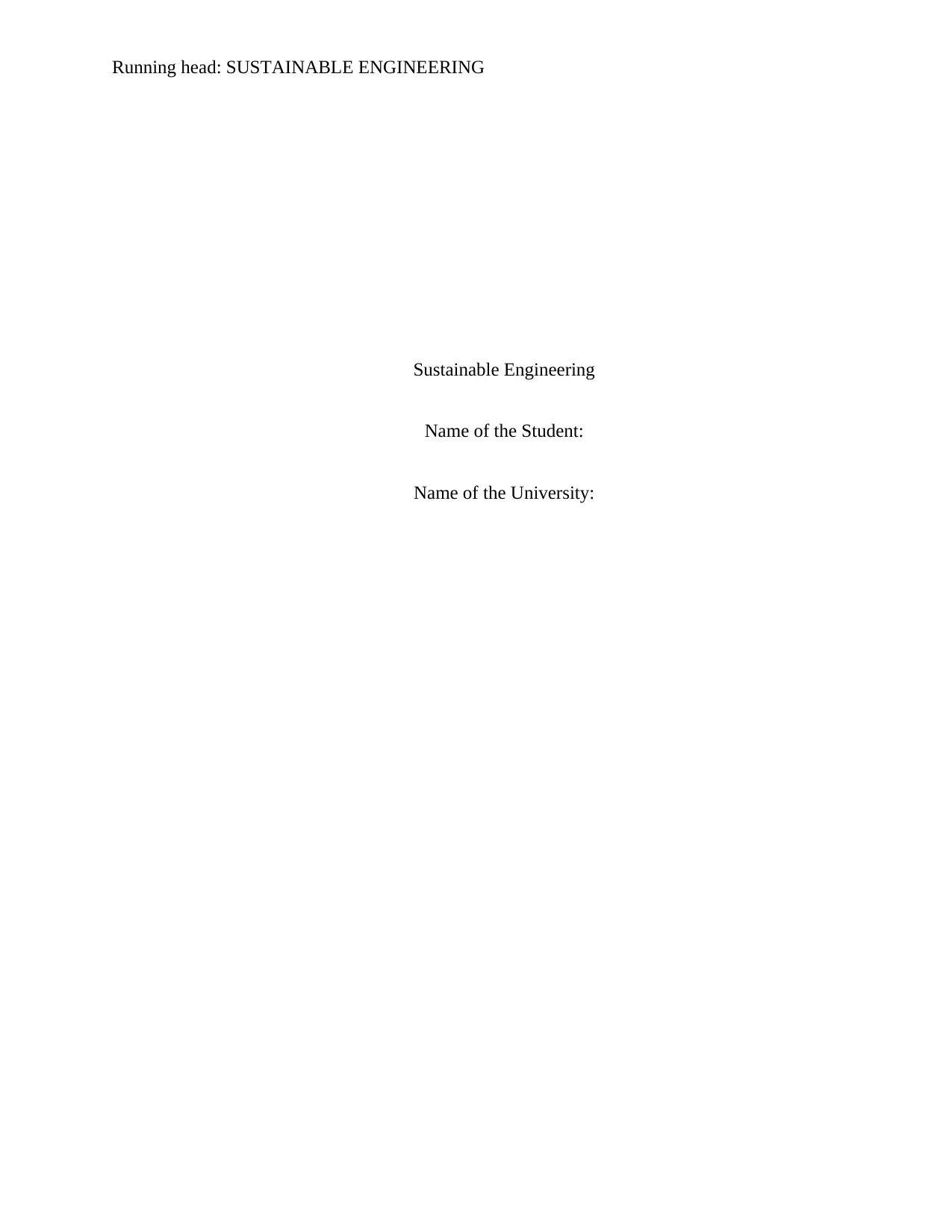
Running head: SUSTAINABLE ENGINEERING
Sustainable Engineering
Name of the Student:
Name of the University:
Sustainable Engineering
Name of the Student:
Name of the University:
Paraphrase This Document
Need a fresh take? Get an instant paraphrase of this document with our AI Paraphraser
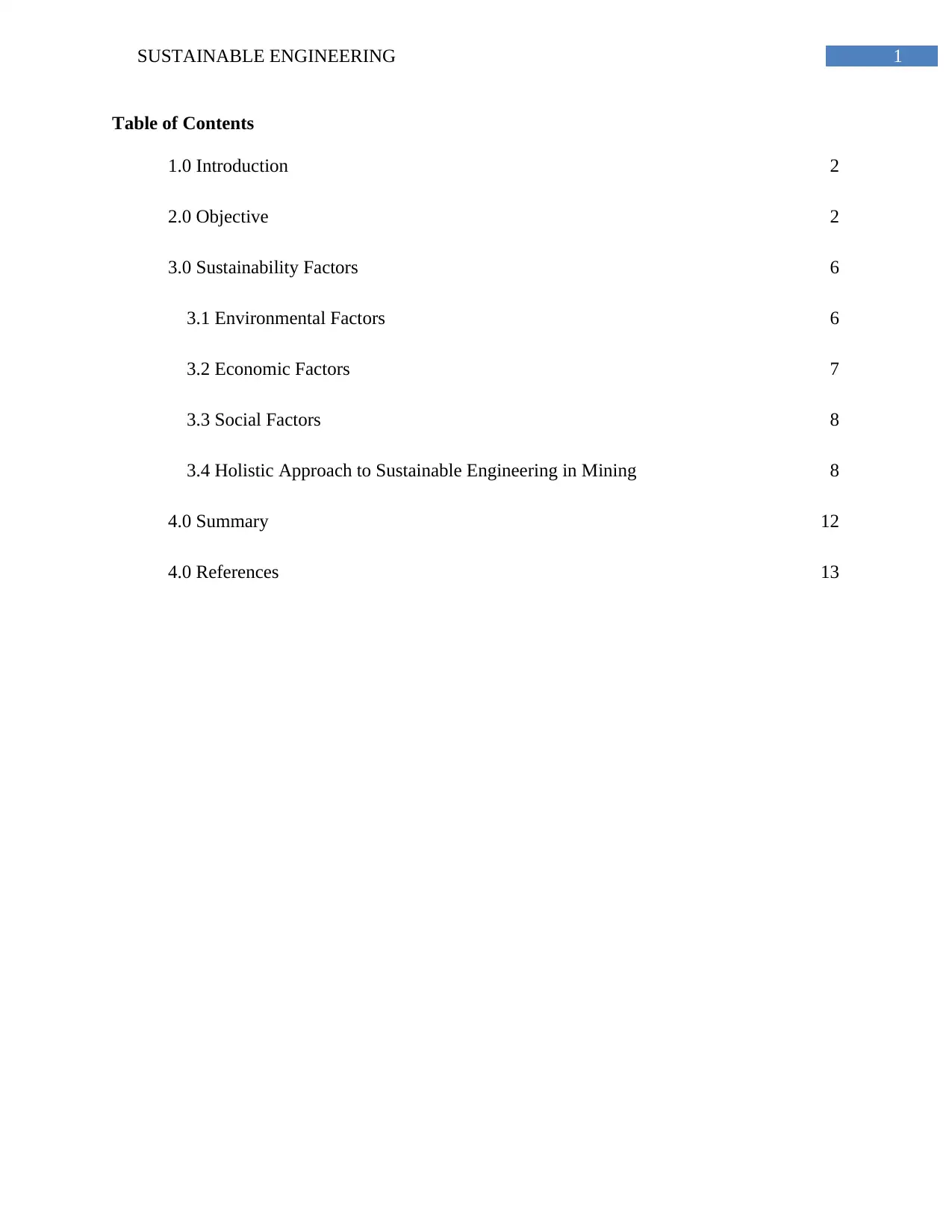
1SUSTAINABLE ENGINEERING
Table of Contents
1.0 Introduction 2
2.0 Objective 2
3.0 Sustainability Factors 6
3.1 Environmental Factors 6
3.2 Economic Factors 7
3.3 Social Factors 8
3.4 Holistic Approach to Sustainable Engineering in Mining 8
4.0 Summary 12
4.0 References 13
Table of Contents
1.0 Introduction 2
2.0 Objective 2
3.0 Sustainability Factors 6
3.1 Environmental Factors 6
3.2 Economic Factors 7
3.3 Social Factors 8
3.4 Holistic Approach to Sustainable Engineering in Mining 8
4.0 Summary 12
4.0 References 13
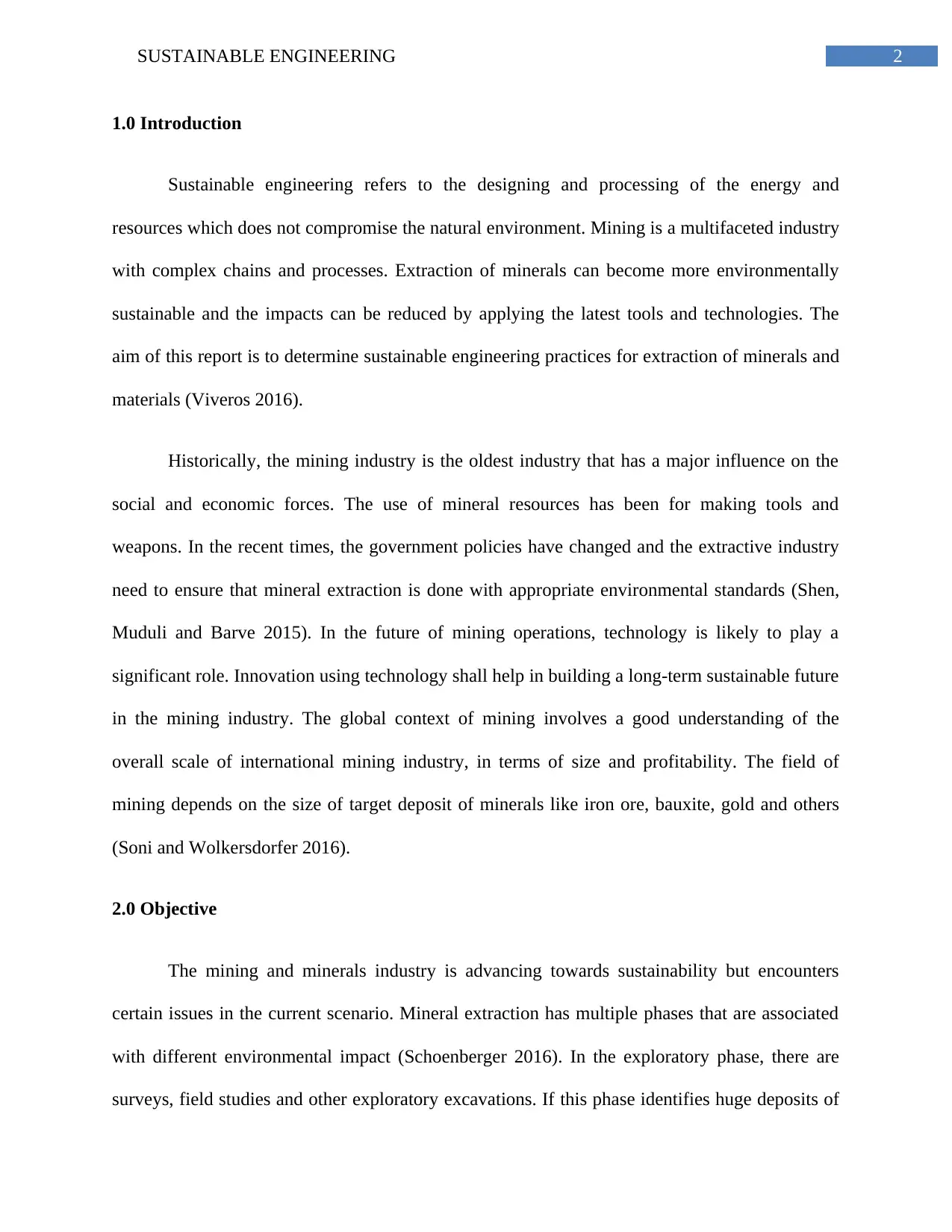
2SUSTAINABLE ENGINEERING
1.0 Introduction
Sustainable engineering refers to the designing and processing of the energy and
resources which does not compromise the natural environment. Mining is a multifaceted industry
with complex chains and processes. Extraction of minerals can become more environmentally
sustainable and the impacts can be reduced by applying the latest tools and technologies. The
aim of this report is to determine sustainable engineering practices for extraction of minerals and
materials (Viveros 2016).
Historically, the mining industry is the oldest industry that has a major influence on the
social and economic forces. The use of mineral resources has been for making tools and
weapons. In the recent times, the government policies have changed and the extractive industry
need to ensure that mineral extraction is done with appropriate environmental standards (Shen,
Muduli and Barve 2015). In the future of mining operations, technology is likely to play a
significant role. Innovation using technology shall help in building a long-term sustainable future
in the mining industry. The global context of mining involves a good understanding of the
overall scale of international mining industry, in terms of size and profitability. The field of
mining depends on the size of target deposit of minerals like iron ore, bauxite, gold and others
(Soni and Wolkersdorfer 2016).
2.0 Objective
The mining and minerals industry is advancing towards sustainability but encounters
certain issues in the current scenario. Mineral extraction has multiple phases that are associated
with different environmental impact (Schoenberger 2016). In the exploratory phase, there are
surveys, field studies and other exploratory excavations. If this phase identifies huge deposits of
1.0 Introduction
Sustainable engineering refers to the designing and processing of the energy and
resources which does not compromise the natural environment. Mining is a multifaceted industry
with complex chains and processes. Extraction of minerals can become more environmentally
sustainable and the impacts can be reduced by applying the latest tools and technologies. The
aim of this report is to determine sustainable engineering practices for extraction of minerals and
materials (Viveros 2016).
Historically, the mining industry is the oldest industry that has a major influence on the
social and economic forces. The use of mineral resources has been for making tools and
weapons. In the recent times, the government policies have changed and the extractive industry
need to ensure that mineral extraction is done with appropriate environmental standards (Shen,
Muduli and Barve 2015). In the future of mining operations, technology is likely to play a
significant role. Innovation using technology shall help in building a long-term sustainable future
in the mining industry. The global context of mining involves a good understanding of the
overall scale of international mining industry, in terms of size and profitability. The field of
mining depends on the size of target deposit of minerals like iron ore, bauxite, gold and others
(Soni and Wolkersdorfer 2016).
2.0 Objective
The mining and minerals industry is advancing towards sustainability but encounters
certain issues in the current scenario. Mineral extraction has multiple phases that are associated
with different environmental impact (Schoenberger 2016). In the exploratory phase, there are
surveys, field studies and other exploratory excavations. If this phase identifies huge deposits of
⊘ This is a preview!⊘
Do you want full access?
Subscribe today to unlock all pages.

Trusted by 1+ million students worldwide
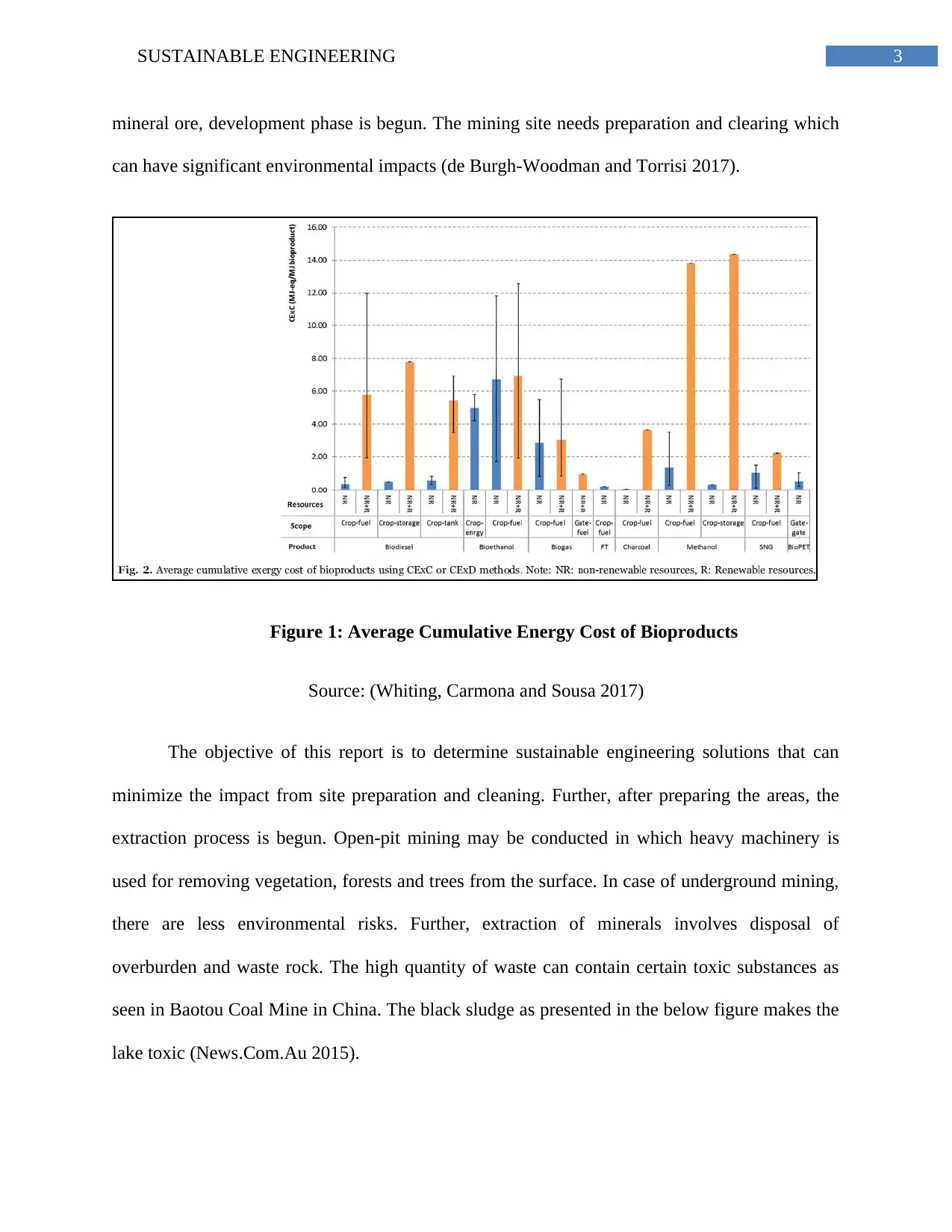
3SUSTAINABLE ENGINEERING
mineral ore, development phase is begun. The mining site needs preparation and clearing which
can have significant environmental impacts (de Burgh-Woodman and Torrisi 2017).
Figure 1: Average Cumulative Energy Cost of Bioproducts
Source: (Whiting, Carmona and Sousa 2017)
The objective of this report is to determine sustainable engineering solutions that can
minimize the impact from site preparation and cleaning. Further, after preparing the areas, the
extraction process is begun. Open-pit mining may be conducted in which heavy machinery is
used for removing vegetation, forests and trees from the surface. In case of underground mining,
there are less environmental risks. Further, extraction of minerals involves disposal of
overburden and waste rock. The high quantity of waste can contain certain toxic substances as
seen in Baotou Coal Mine in China. The black sludge as presented in the below figure makes the
lake toxic (News.Com.Au 2015).
mineral ore, development phase is begun. The mining site needs preparation and clearing which
can have significant environmental impacts (de Burgh-Woodman and Torrisi 2017).
Figure 1: Average Cumulative Energy Cost of Bioproducts
Source: (Whiting, Carmona and Sousa 2017)
The objective of this report is to determine sustainable engineering solutions that can
minimize the impact from site preparation and cleaning. Further, after preparing the areas, the
extraction process is begun. Open-pit mining may be conducted in which heavy machinery is
used for removing vegetation, forests and trees from the surface. In case of underground mining,
there are less environmental risks. Further, extraction of minerals involves disposal of
overburden and waste rock. The high quantity of waste can contain certain toxic substances as
seen in Baotou Coal Mine in China. The black sludge as presented in the below figure makes the
lake toxic (News.Com.Au 2015).
Paraphrase This Document
Need a fresh take? Get an instant paraphrase of this document with our AI Paraphraser
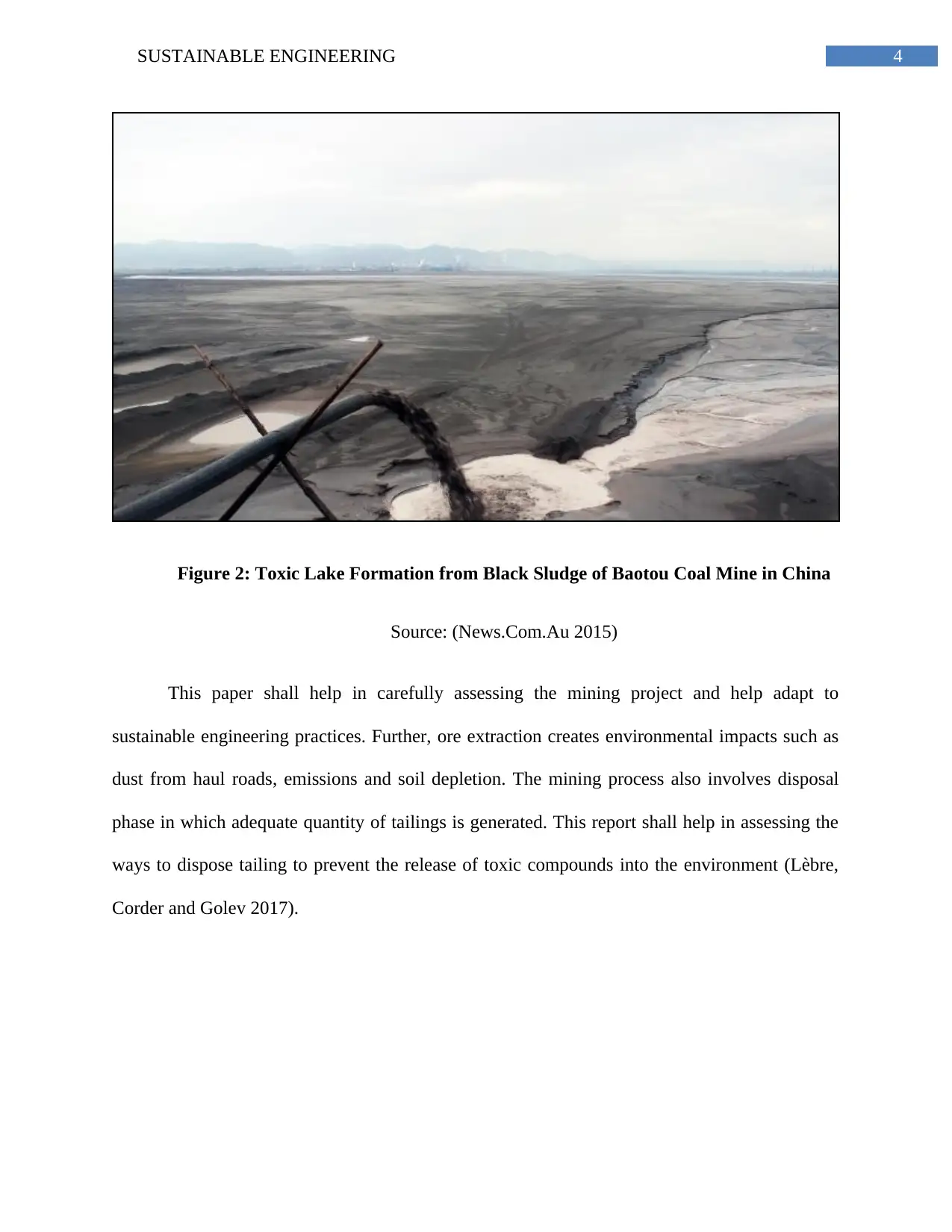
4SUSTAINABLE ENGINEERING
Figure 2: Toxic Lake Formation from Black Sludge of Baotou Coal Mine in China
Source: (News.Com.Au 2015)
This paper shall help in carefully assessing the mining project and help adapt to
sustainable engineering practices. Further, ore extraction creates environmental impacts such as
dust from haul roads, emissions and soil depletion. The mining process also involves disposal
phase in which adequate quantity of tailings is generated. This report shall help in assessing the
ways to dispose tailing to prevent the release of toxic compounds into the environment (Lèbre,
Corder and Golev 2017).
Figure 2: Toxic Lake Formation from Black Sludge of Baotou Coal Mine in China
Source: (News.Com.Au 2015)
This paper shall help in carefully assessing the mining project and help adapt to
sustainable engineering practices. Further, ore extraction creates environmental impacts such as
dust from haul roads, emissions and soil depletion. The mining process also involves disposal
phase in which adequate quantity of tailings is generated. This report shall help in assessing the
ways to dispose tailing to prevent the release of toxic compounds into the environment (Lèbre,
Corder and Golev 2017).
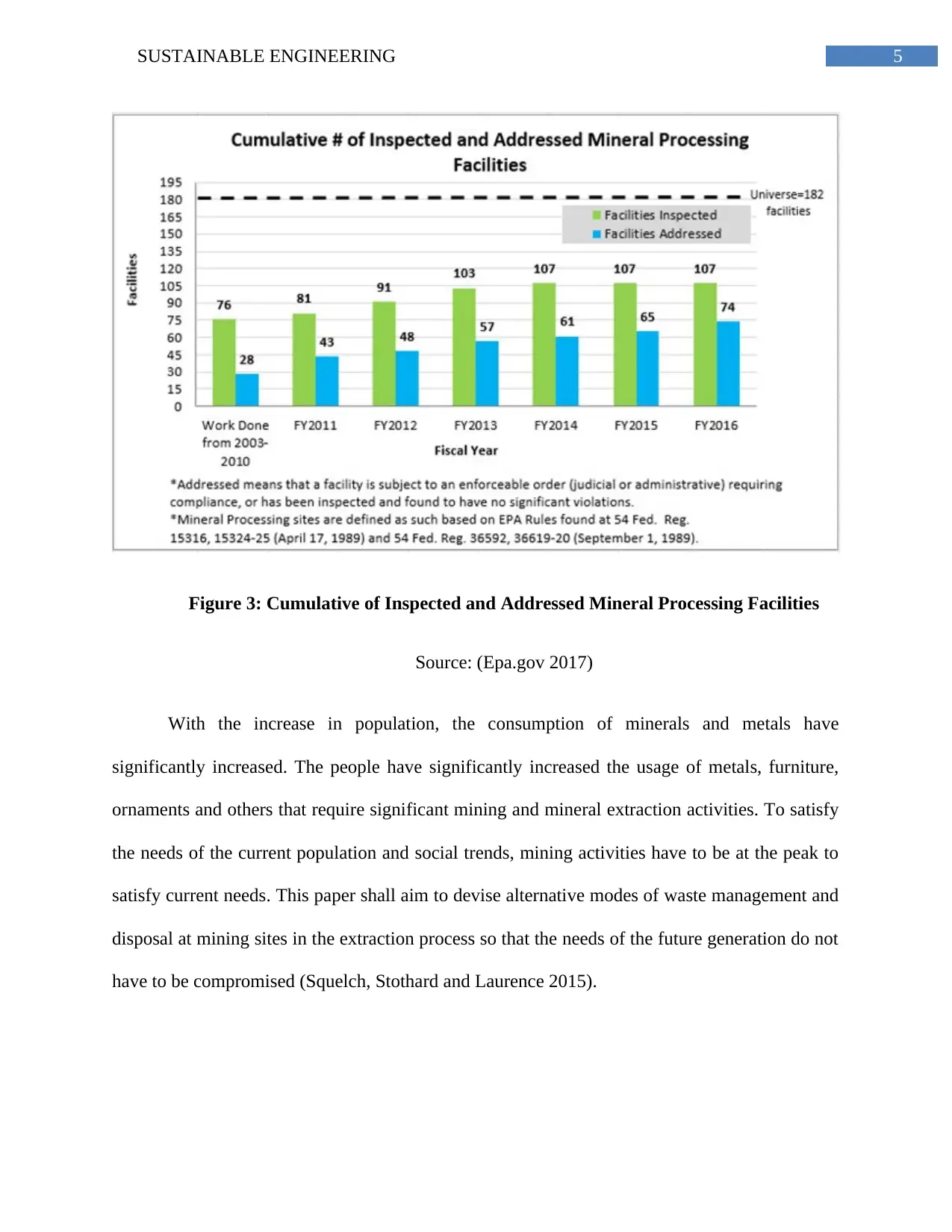
5SUSTAINABLE ENGINEERING
Figure 3: Cumulative of Inspected and Addressed Mineral Processing Facilities
Source: (Epa.gov 2017)
With the increase in population, the consumption of minerals and metals have
significantly increased. The people have significantly increased the usage of metals, furniture,
ornaments and others that require significant mining and mineral extraction activities. To satisfy
the needs of the current population and social trends, mining activities have to be at the peak to
satisfy current needs. This paper shall aim to devise alternative modes of waste management and
disposal at mining sites in the extraction process so that the needs of the future generation do not
have to be compromised (Squelch, Stothard and Laurence 2015).
Figure 3: Cumulative of Inspected and Addressed Mineral Processing Facilities
Source: (Epa.gov 2017)
With the increase in population, the consumption of minerals and metals have
significantly increased. The people have significantly increased the usage of metals, furniture,
ornaments and others that require significant mining and mineral extraction activities. To satisfy
the needs of the current population and social trends, mining activities have to be at the peak to
satisfy current needs. This paper shall aim to devise alternative modes of waste management and
disposal at mining sites in the extraction process so that the needs of the future generation do not
have to be compromised (Squelch, Stothard and Laurence 2015).
⊘ This is a preview!⊘
Do you want full access?
Subscribe today to unlock all pages.

Trusted by 1+ million students worldwide
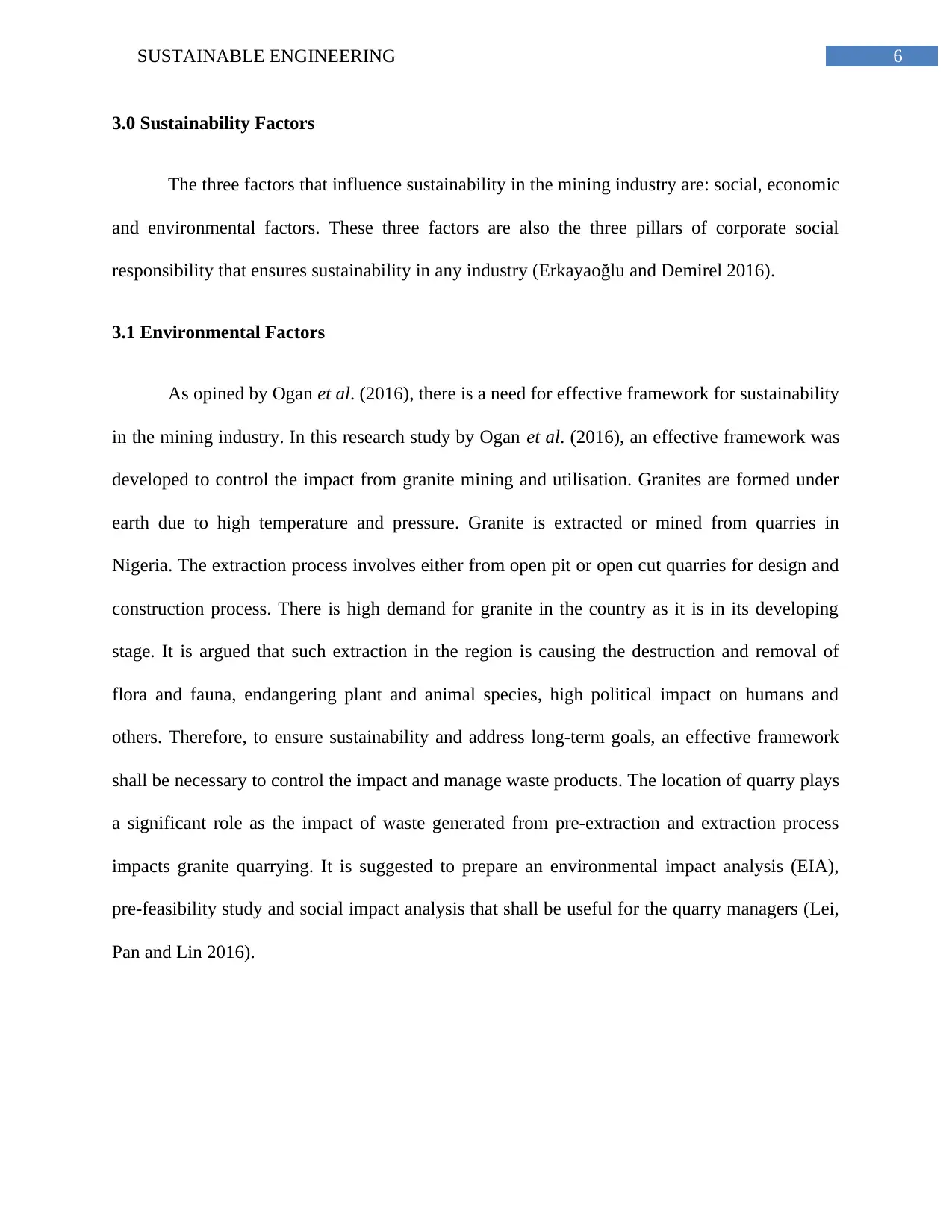
6SUSTAINABLE ENGINEERING
3.0 Sustainability Factors
The three factors that influence sustainability in the mining industry are: social, economic
and environmental factors. These three factors are also the three pillars of corporate social
responsibility that ensures sustainability in any industry (Erkayaoğlu and Demirel 2016).
3.1 Environmental Factors
As opined by Ogan et al. (2016), there is a need for effective framework for sustainability
in the mining industry. In this research study by Ogan et al. (2016), an effective framework was
developed to control the impact from granite mining and utilisation. Granites are formed under
earth due to high temperature and pressure. Granite is extracted or mined from quarries in
Nigeria. The extraction process involves either from open pit or open cut quarries for design and
construction process. There is high demand for granite in the country as it is in its developing
stage. It is argued that such extraction in the region is causing the destruction and removal of
flora and fauna, endangering plant and animal species, high political impact on humans and
others. Therefore, to ensure sustainability and address long-term goals, an effective framework
shall be necessary to control the impact and manage waste products. The location of quarry plays
a significant role as the impact of waste generated from pre-extraction and extraction process
impacts granite quarrying. It is suggested to prepare an environmental impact analysis (EIA),
pre-feasibility study and social impact analysis that shall be useful for the quarry managers (Lei,
Pan and Lin 2016).
3.0 Sustainability Factors
The three factors that influence sustainability in the mining industry are: social, economic
and environmental factors. These three factors are also the three pillars of corporate social
responsibility that ensures sustainability in any industry (Erkayaoğlu and Demirel 2016).
3.1 Environmental Factors
As opined by Ogan et al. (2016), there is a need for effective framework for sustainability
in the mining industry. In this research study by Ogan et al. (2016), an effective framework was
developed to control the impact from granite mining and utilisation. Granites are formed under
earth due to high temperature and pressure. Granite is extracted or mined from quarries in
Nigeria. The extraction process involves either from open pit or open cut quarries for design and
construction process. There is high demand for granite in the country as it is in its developing
stage. It is argued that such extraction in the region is causing the destruction and removal of
flora and fauna, endangering plant and animal species, high political impact on humans and
others. Therefore, to ensure sustainability and address long-term goals, an effective framework
shall be necessary to control the impact and manage waste products. The location of quarry plays
a significant role as the impact of waste generated from pre-extraction and extraction process
impacts granite quarrying. It is suggested to prepare an environmental impact analysis (EIA),
pre-feasibility study and social impact analysis that shall be useful for the quarry managers (Lei,
Pan and Lin 2016).
Paraphrase This Document
Need a fresh take? Get an instant paraphrase of this document with our AI Paraphraser
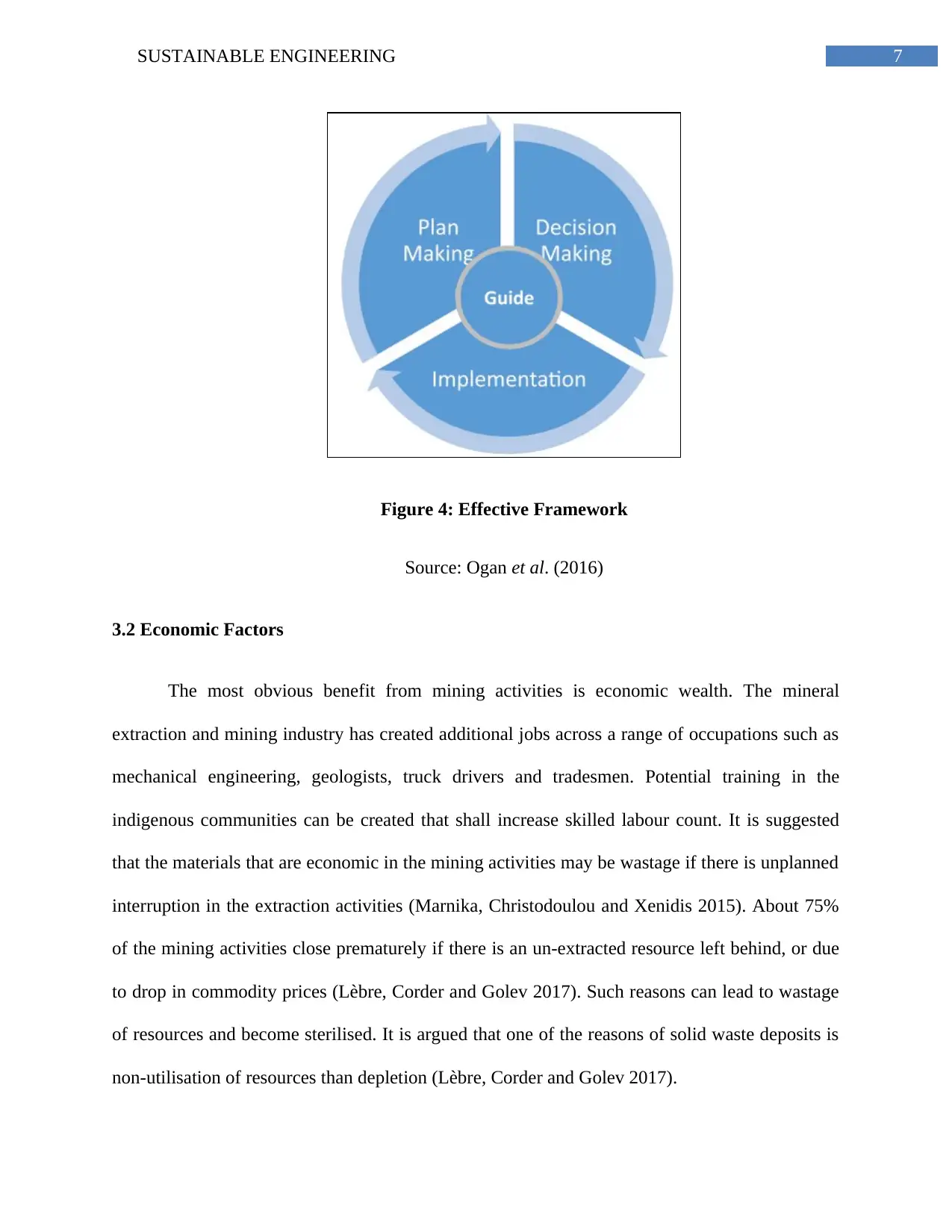
7SUSTAINABLE ENGINEERING
Figure 4: Effective Framework
Source: Ogan et al. (2016)
3.2 Economic Factors
The most obvious benefit from mining activities is economic wealth. The mineral
extraction and mining industry has created additional jobs across a range of occupations such as
mechanical engineering, geologists, truck drivers and tradesmen. Potential training in the
indigenous communities can be created that shall increase skilled labour count. It is suggested
that the materials that are economic in the mining activities may be wastage if there is unplanned
interruption in the extraction activities (Marnika, Christodoulou and Xenidis 2015). About 75%
of the mining activities close prematurely if there is an un-extracted resource left behind, or due
to drop in commodity prices (Lèbre, Corder and Golev 2017). Such reasons can lead to wastage
of resources and become sterilised. It is argued that one of the reasons of solid waste deposits is
non-utilisation of resources than depletion (Lèbre, Corder and Golev 2017).
Figure 4: Effective Framework
Source: Ogan et al. (2016)
3.2 Economic Factors
The most obvious benefit from mining activities is economic wealth. The mineral
extraction and mining industry has created additional jobs across a range of occupations such as
mechanical engineering, geologists, truck drivers and tradesmen. Potential training in the
indigenous communities can be created that shall increase skilled labour count. It is suggested
that the materials that are economic in the mining activities may be wastage if there is unplanned
interruption in the extraction activities (Marnika, Christodoulou and Xenidis 2015). About 75%
of the mining activities close prematurely if there is an un-extracted resource left behind, or due
to drop in commodity prices (Lèbre, Corder and Golev 2017). Such reasons can lead to wastage
of resources and become sterilised. It is argued that one of the reasons of solid waste deposits is
non-utilisation of resources than depletion (Lèbre, Corder and Golev 2017).
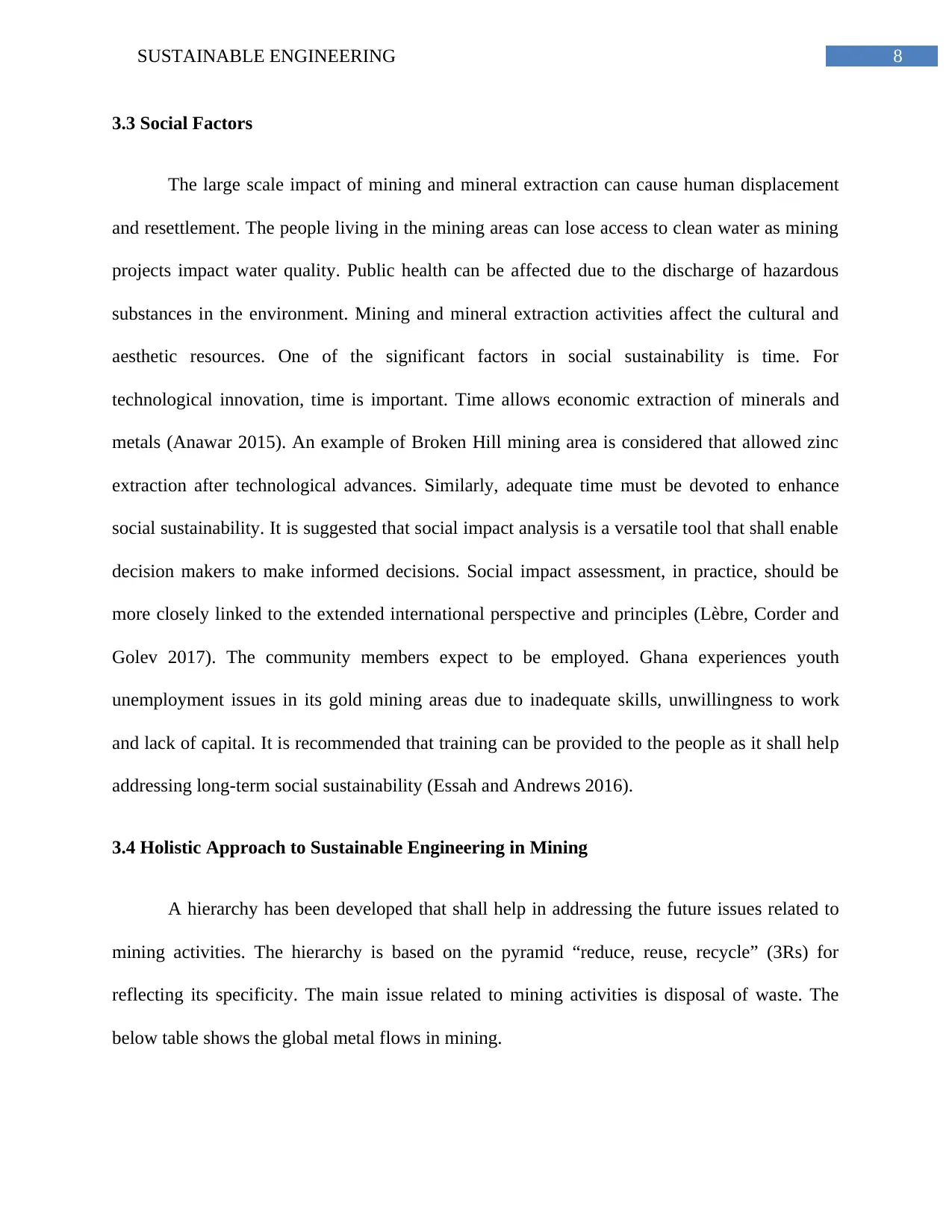
8SUSTAINABLE ENGINEERING
3.3 Social Factors
The large scale impact of mining and mineral extraction can cause human displacement
and resettlement. The people living in the mining areas can lose access to clean water as mining
projects impact water quality. Public health can be affected due to the discharge of hazardous
substances in the environment. Mining and mineral extraction activities affect the cultural and
aesthetic resources. One of the significant factors in social sustainability is time. For
technological innovation, time is important. Time allows economic extraction of minerals and
metals (Anawar 2015). An example of Broken Hill mining area is considered that allowed zinc
extraction after technological advances. Similarly, adequate time must be devoted to enhance
social sustainability. It is suggested that social impact analysis is a versatile tool that shall enable
decision makers to make informed decisions. Social impact assessment, in practice, should be
more closely linked to the extended international perspective and principles (Lèbre, Corder and
Golev 2017). The community members expect to be employed. Ghana experiences youth
unemployment issues in its gold mining areas due to inadequate skills, unwillingness to work
and lack of capital. It is recommended that training can be provided to the people as it shall help
addressing long-term social sustainability (Essah and Andrews 2016).
3.4 Holistic Approach to Sustainable Engineering in Mining
A hierarchy has been developed that shall help in addressing the future issues related to
mining activities. The hierarchy is based on the pyramid “reduce, reuse, recycle” (3Rs) for
reflecting its specificity. The main issue related to mining activities is disposal of waste. The
below table shows the global metal flows in mining.
3.3 Social Factors
The large scale impact of mining and mineral extraction can cause human displacement
and resettlement. The people living in the mining areas can lose access to clean water as mining
projects impact water quality. Public health can be affected due to the discharge of hazardous
substances in the environment. Mining and mineral extraction activities affect the cultural and
aesthetic resources. One of the significant factors in social sustainability is time. For
technological innovation, time is important. Time allows economic extraction of minerals and
metals (Anawar 2015). An example of Broken Hill mining area is considered that allowed zinc
extraction after technological advances. Similarly, adequate time must be devoted to enhance
social sustainability. It is suggested that social impact analysis is a versatile tool that shall enable
decision makers to make informed decisions. Social impact assessment, in practice, should be
more closely linked to the extended international perspective and principles (Lèbre, Corder and
Golev 2017). The community members expect to be employed. Ghana experiences youth
unemployment issues in its gold mining areas due to inadequate skills, unwillingness to work
and lack of capital. It is recommended that training can be provided to the people as it shall help
addressing long-term social sustainability (Essah and Andrews 2016).
3.4 Holistic Approach to Sustainable Engineering in Mining
A hierarchy has been developed that shall help in addressing the future issues related to
mining activities. The hierarchy is based on the pyramid “reduce, reuse, recycle” (3Rs) for
reflecting its specificity. The main issue related to mining activities is disposal of waste. The
below table shows the global metal flows in mining.
⊘ This is a preview!⊘
Do you want full access?
Subscribe today to unlock all pages.

Trusted by 1+ million students worldwide
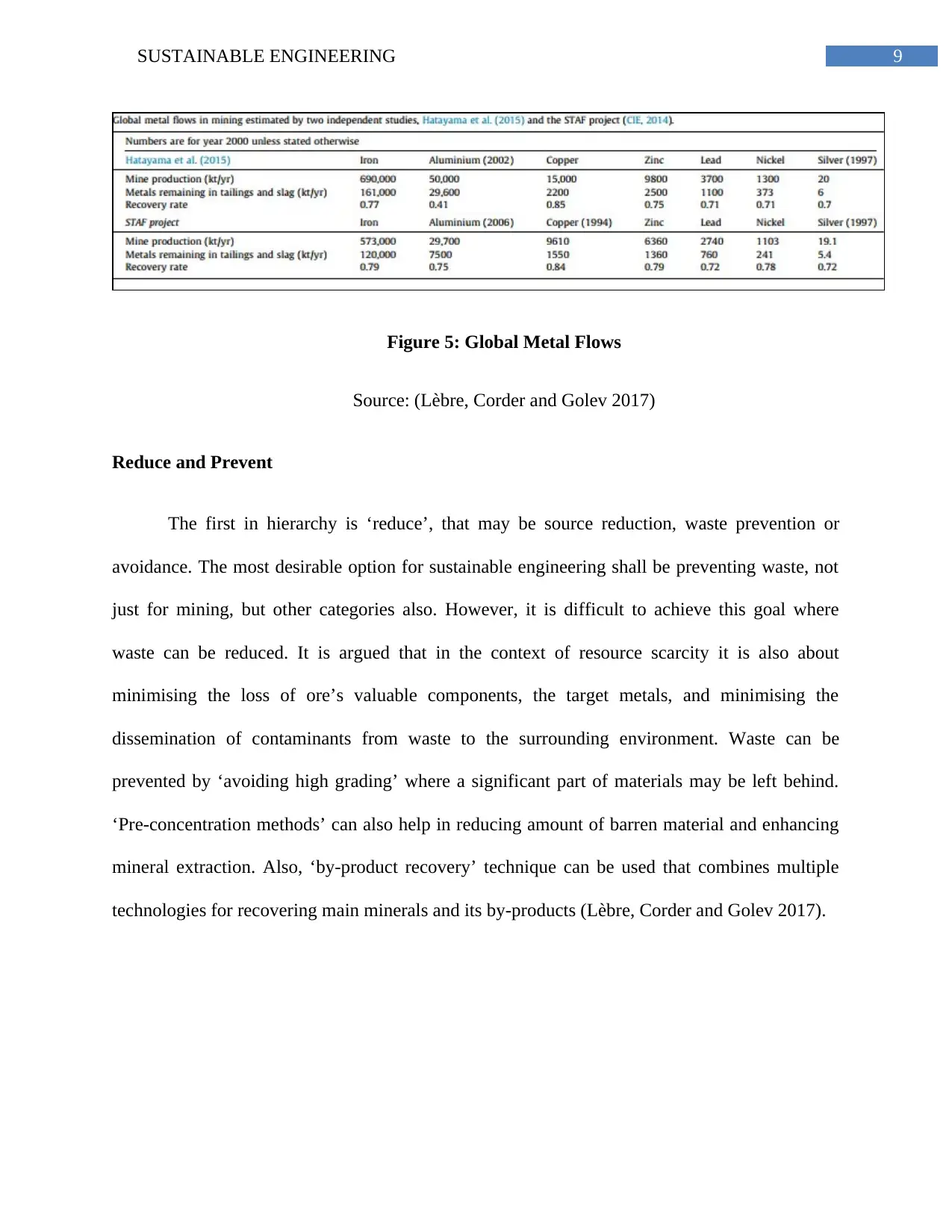
9SUSTAINABLE ENGINEERING
Figure 5: Global Metal Flows
Source: (Lèbre, Corder and Golev 2017)
Reduce and Prevent
The first in hierarchy is ‘reduce’, that may be source reduction, waste prevention or
avoidance. The most desirable option for sustainable engineering shall be preventing waste, not
just for mining, but other categories also. However, it is difficult to achieve this goal where
waste can be reduced. It is argued that in the context of resource scarcity it is also about
minimising the loss of ore’s valuable components, the target metals, and minimising the
dissemination of contaminants from waste to the surrounding environment. Waste can be
prevented by ‘avoiding high grading’ where a significant part of materials may be left behind.
‘Pre-concentration methods’ can also help in reducing amount of barren material and enhancing
mineral extraction. Also, ‘by-product recovery’ technique can be used that combines multiple
technologies for recovering main minerals and its by-products (Lèbre, Corder and Golev 2017).
Figure 5: Global Metal Flows
Source: (Lèbre, Corder and Golev 2017)
Reduce and Prevent
The first in hierarchy is ‘reduce’, that may be source reduction, waste prevention or
avoidance. The most desirable option for sustainable engineering shall be preventing waste, not
just for mining, but other categories also. However, it is difficult to achieve this goal where
waste can be reduced. It is argued that in the context of resource scarcity it is also about
minimising the loss of ore’s valuable components, the target metals, and minimising the
dissemination of contaminants from waste to the surrounding environment. Waste can be
prevented by ‘avoiding high grading’ where a significant part of materials may be left behind.
‘Pre-concentration methods’ can also help in reducing amount of barren material and enhancing
mineral extraction. Also, ‘by-product recovery’ technique can be used that combines multiple
technologies for recovering main minerals and its by-products (Lèbre, Corder and Golev 2017).
Paraphrase This Document
Need a fresh take? Get an instant paraphrase of this document with our AI Paraphraser
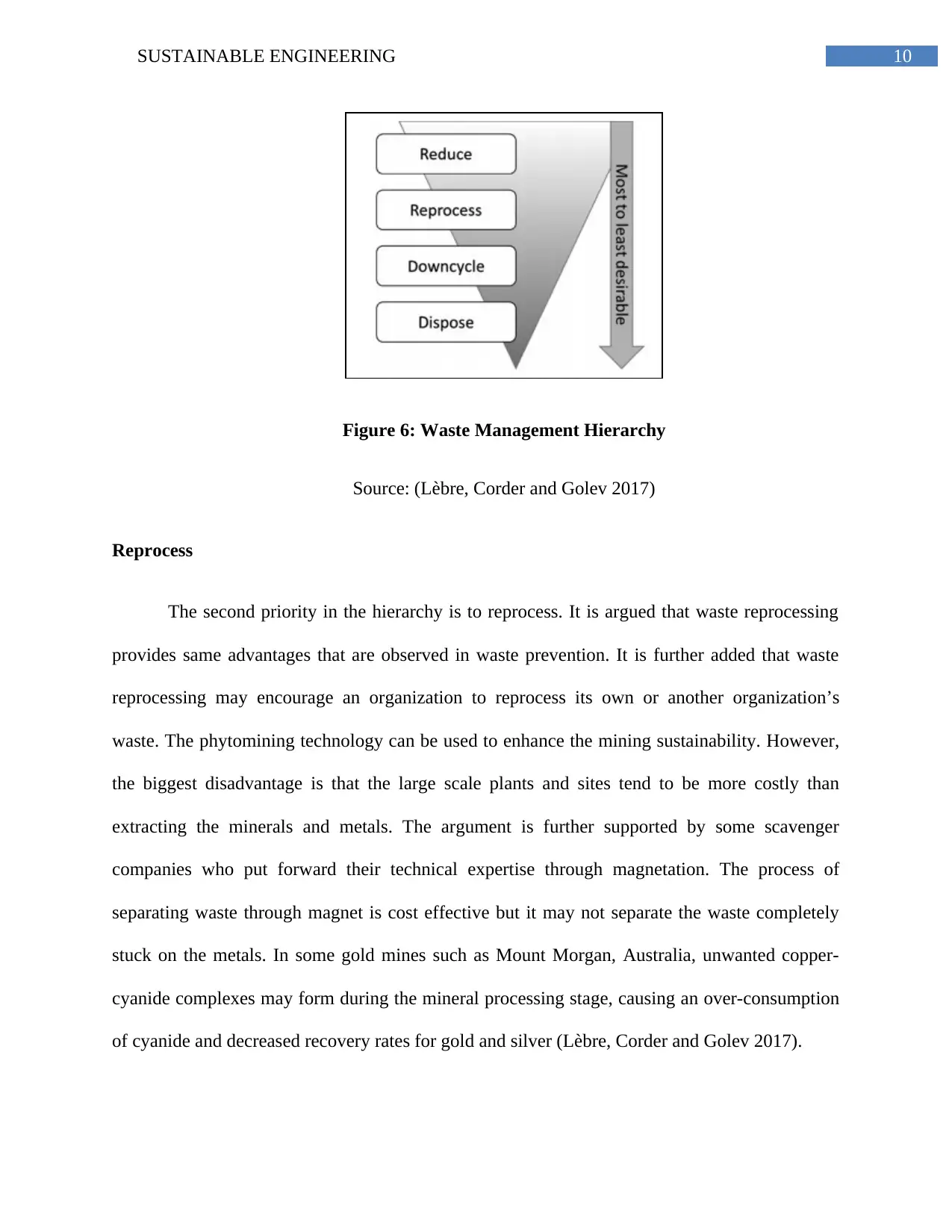
10SUSTAINABLE ENGINEERING
Figure 6: Waste Management Hierarchy
Source: (Lèbre, Corder and Golev 2017)
Reprocess
The second priority in the hierarchy is to reprocess. It is argued that waste reprocessing
provides same advantages that are observed in waste prevention. It is further added that waste
reprocessing may encourage an organization to reprocess its own or another organization’s
waste. The phytomining technology can be used to enhance the mining sustainability. However,
the biggest disadvantage is that the large scale plants and sites tend to be more costly than
extracting the minerals and metals. The argument is further supported by some scavenger
companies who put forward their technical expertise through magnetation. The process of
separating waste through magnet is cost effective but it may not separate the waste completely
stuck on the metals. In some gold mines such as Mount Morgan, Australia, unwanted copper-
cyanide complexes may form during the mineral processing stage, causing an over-consumption
of cyanide and decreased recovery rates for gold and silver (Lèbre, Corder and Golev 2017).
Figure 6: Waste Management Hierarchy
Source: (Lèbre, Corder and Golev 2017)
Reprocess
The second priority in the hierarchy is to reprocess. It is argued that waste reprocessing
provides same advantages that are observed in waste prevention. It is further added that waste
reprocessing may encourage an organization to reprocess its own or another organization’s
waste. The phytomining technology can be used to enhance the mining sustainability. However,
the biggest disadvantage is that the large scale plants and sites tend to be more costly than
extracting the minerals and metals. The argument is further supported by some scavenger
companies who put forward their technical expertise through magnetation. The process of
separating waste through magnet is cost effective but it may not separate the waste completely
stuck on the metals. In some gold mines such as Mount Morgan, Australia, unwanted copper-
cyanide complexes may form during the mineral processing stage, causing an over-consumption
of cyanide and decreased recovery rates for gold and silver (Lèbre, Corder and Golev 2017).
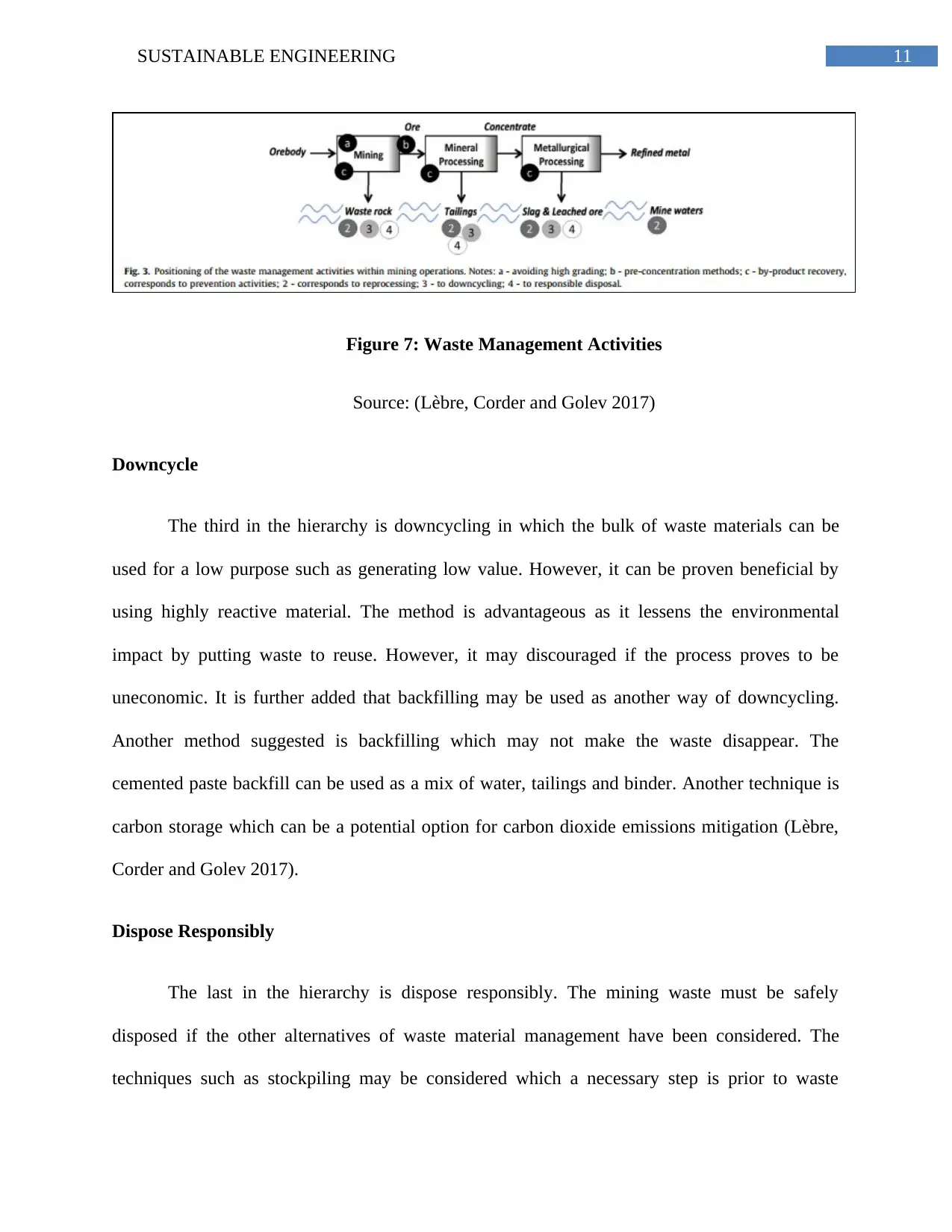
11SUSTAINABLE ENGINEERING
Figure 7: Waste Management Activities
Source: (Lèbre, Corder and Golev 2017)
Downcycle
The third in the hierarchy is downcycling in which the bulk of waste materials can be
used for a low purpose such as generating low value. However, it can be proven beneficial by
using highly reactive material. The method is advantageous as it lessens the environmental
impact by putting waste to reuse. However, it may discouraged if the process proves to be
uneconomic. It is further added that backfilling may be used as another way of downcycling.
Another method suggested is backfilling which may not make the waste disappear. The
cemented paste backfill can be used as a mix of water, tailings and binder. Another technique is
carbon storage which can be a potential option for carbon dioxide emissions mitigation (Lèbre,
Corder and Golev 2017).
Dispose Responsibly
The last in the hierarchy is dispose responsibly. The mining waste must be safely
disposed if the other alternatives of waste material management have been considered. The
techniques such as stockpiling may be considered which a necessary step is prior to waste
Figure 7: Waste Management Activities
Source: (Lèbre, Corder and Golev 2017)
Downcycle
The third in the hierarchy is downcycling in which the bulk of waste materials can be
used for a low purpose such as generating low value. However, it can be proven beneficial by
using highly reactive material. The method is advantageous as it lessens the environmental
impact by putting waste to reuse. However, it may discouraged if the process proves to be
uneconomic. It is further added that backfilling may be used as another way of downcycling.
Another method suggested is backfilling which may not make the waste disappear. The
cemented paste backfill can be used as a mix of water, tailings and binder. Another technique is
carbon storage which can be a potential option for carbon dioxide emissions mitigation (Lèbre,
Corder and Golev 2017).
Dispose Responsibly
The last in the hierarchy is dispose responsibly. The mining waste must be safely
disposed if the other alternatives of waste material management have been considered. The
techniques such as stockpiling may be considered which a necessary step is prior to waste
⊘ This is a preview!⊘
Do you want full access?
Subscribe today to unlock all pages.

Trusted by 1+ million students worldwide
1 out of 16
Your All-in-One AI-Powered Toolkit for Academic Success.
+13062052269
info@desklib.com
Available 24*7 on WhatsApp / Email
![[object Object]](/_next/static/media/star-bottom.7253800d.svg)
Unlock your academic potential
Copyright © 2020–2025 A2Z Services. All Rights Reserved. Developed and managed by ZUCOL.